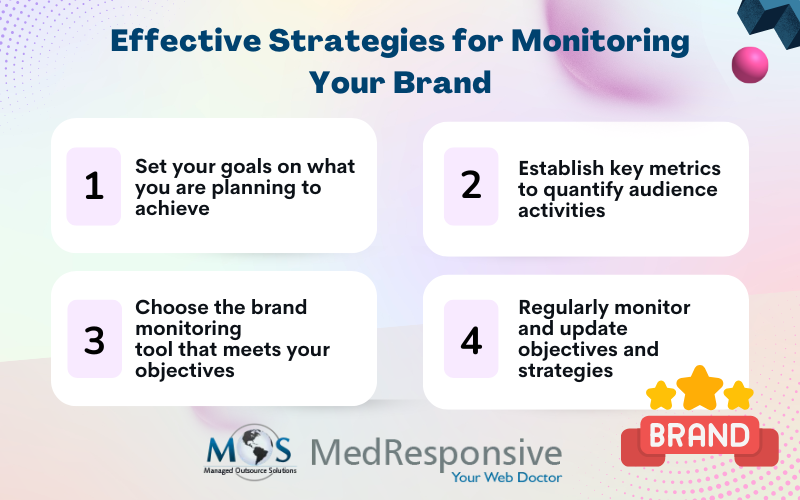Just the click of a button. That’s all it takes for someone to share their experience regarding a product or service. And, with a retweet or a repost, it won’t be long before the news spreads across the digital vastlands like wildfire. With social media constantly buzzing with reviews, comments and feedback, it is difficult for a brand to keep an eye on everything that’s happening out there. But, without such vigilance, brands would not only lose their relevance, but also their credibility (at least amongst netizens).
That’s where brand monitoring takes center stage!
Think of brand monitoring as an online brand watchdog that relentlessly sweeps through endless corners of the vast digital landscape—listening to customers’ comments, keeping track of their online activities, and even gathering intel on your competitors—all of which can help you answer customer queries, address their concerns, and gain insights to develop the right marketing strategies.
Amongst businesses that have outsourced their technical tasks, more than one-third were digital marketing assignments, second only to IT & Finance. This demonstrates the increasing relevance of digital marketing services to navigate the tricky digital business world with skill and precision. And if online brand reputation is your priority, digital marketing experts can take care of this too.
Brand Monitoring
Simply put, brand monitoring is an online reputation management tool. It is done by monitoring popular online platforms like, social media, news/review sites, blogs to understand customer sentiment, spot latest trends, identify issues and respond to feedback at the earliest. This enables the business to understand public perception and sentiment about their product or service.
Different Types of Brand Monitoring
- Social Media Monitoring: Monitoring popular social media platforms and tracking comments, mentions, hashtags etc. related to the brand in order to understand customer sentiment and current trends.
- Review Monitoring: Keeping an eye out for customer feedback on product/service related platforms (that can have an impact on customer’s buying decision) like Google, Amazon, Yelp, etc. which can help identify their pulse and take appropriate actions.
- Media Tracking: Monitoring media outlets—newspapers, TV channels and press releases can help pick out potential issues early and manage them effectively.
- Competitor Monitoring: Regularly tracking competitor activities and customer feedback on their product/service to zero in on the opportunities and identify threats.
- Sentiment Analysis: Engaging online tools to evaluate online emotions (positive, negative or neutral) regarding the brand, thereby helping to identify public sentiment/trends in real-time.
Why is Brand Monitoring Inevitable in Today’s Digital Landscape?
- Reputation Management
86% of customers hesitate to buy from a brand that has online negative reviews (Khoros).
This demonstrates the significance of having a strong reputation for building trust and satisfaction with customers.
- Brand monitoring is what enables brands to keep track of negative emotions online and swiftly address them before they do any image damage. Brand loyalty increases in 64% of customers when companies are responsive to their concerns and show that they care (sproutsocial.com).
- By constantly monitoring their customers’ activities online, it helps the brand maintain a strong reputation, thereby reinforcing customer trust and loyalty and strengthening their position in the market.
- Crisis Management
A PwC study revealed that more than 30% of customers would stop buying from a brand if they had witnessed the brand handle a crisis inappropriately.
That is another role brand monitoring plays in crisis management, enabling brands to identify potential issues and address them timely, before they escalate.
- Using brand monitoring tools can help brands identify negative trends or rise in customer complaints, enabling them to handle it promptly. Regardless of whether it is a customer service issue, social media backlash or product failure, brand monitoring offers a foresight in capturing these challenging issues and addressing them, while maintaining the brand’s reputation.
- Competitive Advantage
89% of executives agreed that monitoring competitors’ activities is essential to stay competitive and strategize effectively (Qualtrics XM Institute).
Brand monitoring opens an unprecedented access into competitors’ actions online, which includes their customer interaction manner, social media strategies and identifying gaps in the market that can be filled.
- Competitor analysis helps identify their strengths and weaknesses, helping brands to capture opportunities and respond to market trends by adjusting their brand strategy. Monitoring can enable brands to understand what and how to target their customers specifically, enabling them to create a strategy that is more targeted.
- Prioritizing Customers
83% of companies who listen to their customers’ feedback, experience a rise in their financials compared to their competitors (Khoros).
Through analyzing reviews, feedback and comments online, brands were able to understand the customer needs, identify preferences and pain points that contribute to an improved product development and customer experience.
- Regularly tracking online discussions about a brand’s product/service offers real-time data which help them to make necessary improvements to align with customers’ expectations. It also helps identify new opportunities or untouched market areas, providing a unique, strategic edge.
Best Practices for Brand Monitoring
Here are some ideas to successfully implement brand monitoring:
- Define Specific Goals: The first step towards brand monitoring is to establish your goals. Ask yourself what you are looking to achieve—improving customer experience, bettering product development or boosting engagement. For instance, if you are focused on improving customer satisfaction, you’d have to monitor your customers’ comments/mentions and respond to their complaints at the very earliest.
- Set Key Metrics: Now the goals are set, it is now time to establish key metrics to monitor. Some of the metrics include:
- Brand Mentions: The number of times a brand is mentioned across all platforms.
- Sentiment Analysis: Understanding the wave of emotions (positive/negative) regarding brand mentions.
- Engagement Rates: The rate of customer interaction with the brand’s social media posts.
- Brand Monitoring Tools: Choosing the right brand monitoring tools help gather actionable insights regarding customers’ interaction with your brand. Hootsuite, Sprout Social, Brandwatch are some of the top brand tracking tools that can provide data like sentiment analysis, user interaction, competitive analysis etc. This will help optimize the effectiveness of monitoring and improve overall results.
- Regular Monitoring: Leaving everything in the hands of monitoring tools is not a safe bet. You’ll have to regularly monitor the digital scape and make periodic adjustments to the current objectives and plans, if you are looking to stay relevant in this fiercely competitive field. In fact, companies who regularly adapt their brand monitoring strategies are the ones to likely come out on top.
Brand monitoring is akin to a digital microscope that lets you see what’s happening with regard to your market, customers and competitors—on a deeper level—which enables you to maintain a strong brand reputation. And by proactively engaging online, in building customer relationships and managing reputation, you are positioning your brand for long-term success. Partnering with a digital marketing services company can support continuous monitoring of your brand and identify potential issues as they arise. This real-time tracking allows for timely action to manage customer feedback, resolve complaints, and prevent negative publicity from escalating.





